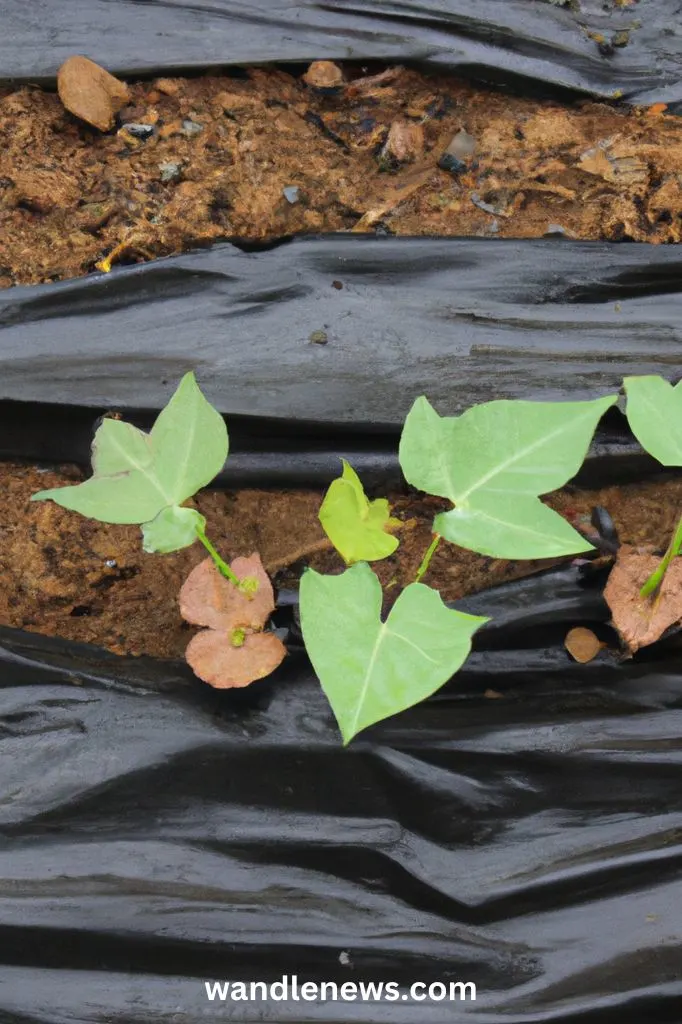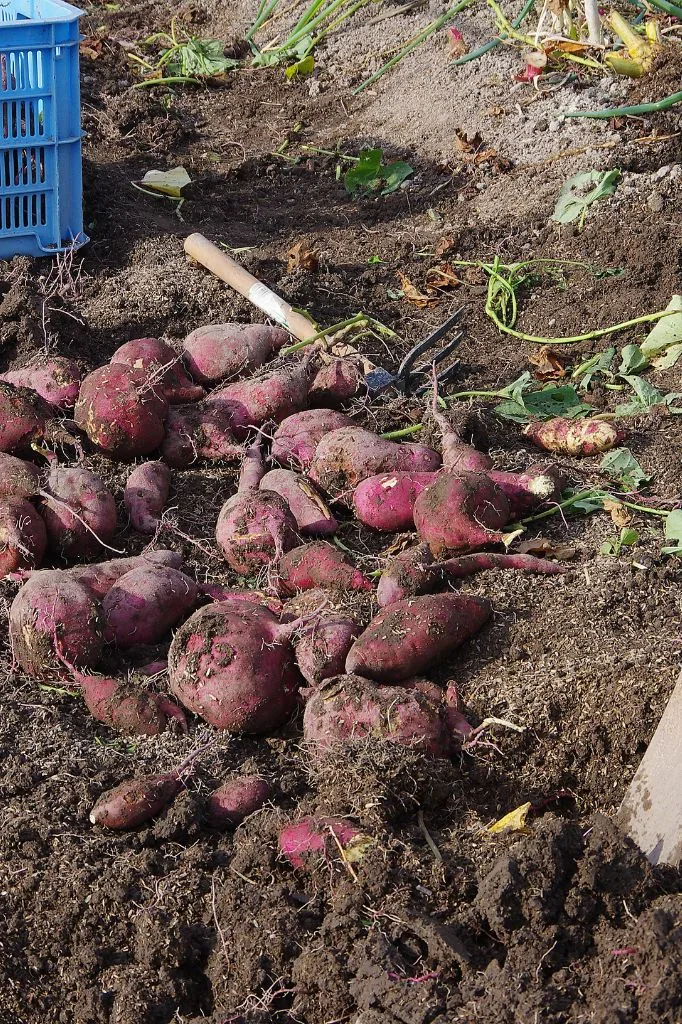While sweet potatoes thrive in warm and humid conditions, it is still possible to grow them in the UK, or other locations which have cooler climates. This post tells you everything you need to know about how to grow sweet potatoes.

How to Grow Sweet Potatoes
Introduction to Growing Sweet Potatoes
Sweet Potato plants (ipomoea batatas) have heart-shaped, lush green leaves, and trumpet-shaped flowers that can be white, pink, or purple. They also have long trailing stems, which can reach 1.5 metres in length, and can be trained to grow up a cane.
Sweet potatoes are not related to regular potatoes. Unlike the white potato, they have a sweet taste, and are rich in vitamins C and A. They can be roasted, boiled, or made into sweet potato fries.
| Quick Guide to Growing Sweet Potatoes | |
|---|---|
| When to Plant | May / June |
| When to Harvest | September / October |
| What they like | Heat, full sun, regular watering |
| What they dislike | Frost |
| Ideal Soil | Sandy, well-draining, slightly acidic to neutral soil |

Where to Grow Sweet Potatoes
Temperature
Sweet Potatoes are best grown in a greenhouse as they like warm environments, typically at temperatures of 21–26°C (70–80°F). It is possible to grow them outside in colder climates, but the crop will be smaller if the temperature they are grown in is lower.
If you are planting your sweet potatoes outside, you should choose a sunny, sheltered spot. You can pre-warm the soil using black polythene, and then cut a hole in the polythene to plant the potato. This will keep the soil warm, and increase your chances of a good crop.

Soil
The ideal soil for growing sweet potatoes is sandy, well-draining soil enriched with organic matter. This type of soil allows for proper root development and prevents waterlogging, which can lead to rot.
If your soil is made up of heavy clay, you can amend it using compost, and adding 43-50% sand. If the soil doesn’t drain well, you can grow your sweet potatoes in large containers. Be aware however, that sweet potatoes spread widely, so be sure to leave enough planting space.
Sweet potatoes also thrive in soil that has a slightly acidic to neutral pH level, (around 5.8 to 6.2).
Make sure you prepare the soil adequately by loosening it and incorporating compost or well-rotted organic matter.
Sweet potatoes are usually grown from cuttings of existing plants. You can buy your own slips from your nearest garden center.

Planting Sweet Potatoes
Sweet potatoes are usually grown from slips, which are unrooted cuttings from existing plants. You can buy the slips at your local garden center, or via mail order from April onwards. When your slips arrive, put them into a jar of water for a couple of days before planting them.
Wait until around 3-4 weeks after the last frost before planting the slips, and aim to space them about 12-18 inches apart, in rows that are 3-4 feet apart. This will give the plants plenty of room to grow. Also, try to bury as much of the stem as possible, as this will encourage the roots to develop.
Make sure to plant your sweet potatoes in a sunny location, as these plants love sunlight. Ideally they like to have a minimum of 6 hours direct sun per day. Ensure you have sandy well-drained soil (around 43-50% sand) for the sweet potato roots to grow in.
Tip: Many gardeners plant their slips in holes in black plastic mulch, to keep the soil temperature warm, and encourage a large crop.

Caring for Sweet Potatoes
To ensure robust growth and a bountiful harvest, proper care of sweet potato plants is essential. Water your plants regularly, aiming for consistent moisture levels in the soil.
Feed them with a high-potash liquid fertiliser, such as tomato food, every fortnight to provide essential nutrients.
Additionally, pinch out the growing tips of longer stems to encourage bushier growth, and provide adequate support, especially if you’re growing them vertically.
Tip: Avoid pruning the sweet potato leaves, as these play a crucial role in producing the food stored in the tuberous roots. If the sweet potato vines extend beyond your desired area, gently lift and redirect them to grow in the desired direction.

Harvesting and Storage
You will know when it is harvest time because the leaves of the sweet potato plant begin to turn yellow and die. This usually happens around 12 -16 weeks after planting. Make sure you harvest before the first frost because frost will damage the sweet potatoes. The harvest usually happens in the late summer or early autumn.
Once you have harvested your potatoes, it is best to cure the skins by exposing them to the sun for a few hours and then putting them in warm place with high humidity, such as a greenhouse, for approximately 10 days. This curing process enhances their flavour and shelf life.
Afterwards, store sweet potatoes in a dry, cool place, regularly checking for signs of rot. Make sure you discard any damaged potatoes, as they can rot and spoil the entire crop.

Varieties of Sweet Potato
The sweet potato is a member of the morning glory family (Convolvulaceae). There are over 6,000 different varieties of sweet potato in the world.
Below are twelve delicious varieties that grow in the UK, Europe and the United States.
- Georgia Jet: A classic sweet potato known for its rich flavour and vibrant orange flesh.
- Beauregard Improved: This variety boasts orange flesh with a sweet flavour, making it a beloved choice for its versatility in cooking.
- Bonita: Characterised by pinkish tubers with orange flesh, Bonita sweet potatoes offer a delightful balance of colour and taste, ideal for various culinary uses.
- Korean Purple: Exhibits purple skin and white flesh, providing a unique flavour and vibrant appearance.
- Kaukura: Featuring light orange skin and flesh, Kaukura sweet potatoes are a visually appealing choice, perfect for adding colour to your dishes.
- Tahiti: With purple-skinned and white-fleshed tubers, Tahiti sweet potatoes are a unique option, offering a distinct flavour and appearance.
- Covington: Covington sweet potatoes are prized for their sweet, orange flesh, making them a favourite for classic sweet potato recipes.
- Murasaki: A Japanese variety, Murasaki sweet potatoes have striking purple skin and white flesh, offering a visually appealing and delicious option.
- O’Henry: These cream-coloured sweet potatoes are known for their slightly nutty flavour, adding a unique twist to your sweet potato dishes.
- Jewel: Renowned for their vibrant orange colour and sweet taste, Jewel sweet potatoes are versatile and perfect for various culinary creations.
- Purple Passion: With deep purple skin and flesh, Purple Passion sweet potatoes are a visually stunning choice that adds a pop of colour to your dishes.
- Porto Rico: This orange-fleshed variety has a classic sweet potato taste, making it a reliable and versatile option for cooking.
These sweet potato varieties each have unique characteristics, making them suitable for various culinary uses.

Common Problems and Solutions
While growing sweet potatoes in the UK can be rewarding, there are common issues that gardeners may encounter. One prevalent problem is pest infestation, with potential culprits like slugs, aphids, and sweet potato weevils. To mitigate these issues, employ natural pest control methods such as diatomaceous earth or companion planting with pest-repelling herbs.
Additionally, keep an eye out for diseases like black rot or white mould, which can affect sweet potatoes. Proper soil drainage and avoiding overcrowding of plants can help prevent these diseases.
Weeds can also pose a challenge, so regular weeding is essential to reduce competition for nutrients.
Be aware of the danger of frost. Sweet potatoes are tropical plants, and although it’s possible to grow them in a cold climate, a light frost could damage your crop.

Gardening Posts
I hope you found this post about how to grow sweet potatoes helpful. Find more gardening ideas and tips below.
- 31 Plants to Grow Around Your Pond
- What is a Strawberry Tree & is the Fruit Edible?
- How to Make Hydrangeas Blue Using Vinegar
- 11 Flowers that Attract Butterflies but not Bees
This Post was About How to Grow Sweet Potatoes
Thank you for reading my post on how to grow sweet potatoes. Now you know how to grow your own sweet potatoes, you won’t need to buy them from the grocery store! If you have any sweet potato gardening tips, please leave me a comment below.
